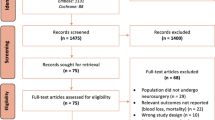Abstract
Background
This study investigates platelet dysfunction in patients with subdural hematomas (SDH) using platelet function analysis (PFA).
Methods
PFA using the PFA-100 (Dade International Inc., Miami, FL) was performed at admission using the collagen–epinephrine and collagen–ADP assays in 58 SDH patients. Clinical and radiologic information was collected.
Results
Normal PFA results were present in 36 patients (62%; PFA collagen:epinephrine assay (s) 118 ave; PFA collagen:adenosine diphosphate assay (s) ave 75) and abnormal platelet function in 22 patients (38%; PFA collagen:epinephrine assay (s) 231 average; PFA collagen:adenosine diphosphate assay (s) 124 average). Compared to patients with normal PFA results, patients with abnormal PFA results were more likely to have hypertension (22 vs. 55%; P = 0.01), take clopidogrel (3 vs. 32%; P = 0.001), and use anti-platelet medications and non-steroidal anti-inflammatory agents (22 vs. 59%; P = 0.004). Measurements of baseline CT for midline shift, maximum thickness, presence of blood/fluid levels in the hematoma, and presence of additional sites of intracranial bleeding did not reveal significant differences based on PFA testing. Platelet dysfunction improved after platelet transfusions (PFA collagen:epinephrine assay: baseline 270 s, CI 61 s; after transfusion 124 s, CI 50 s, P < 0.001).
Conclusion
Platelet dysfunction was found in 38% of SDH patients. This finding adds to our understanding of the pathophysiology of SDH. Since platelet transfusions are indicated for platelet dysfunction accompanied by major bleeding or need for surgery, these results impact peri-operative management.



Similar content being viewed by others
References
Konig SA, Schick U, Dohnert J, goldammer A, Vitzthum HE. Coagulopathy and outcome in patients with chronic subdural haematoma. Acta Neurol Scand. 2003;107:110–6.
Panicker JN, Pavithran K, Thomas M. Management of subdural hematoma in immune thrombocytopenic purpura: report of seven patients and a literature review. Clin Neurol Neurosurg. 2009;111:189–92.
Leonard A, Shapiro FL. Subdural hematoma in regularly hemodialyzed patients. Ann Intern Med. 1975;82:650–8.
Boccardo P, Remuzzi G, Galbusera M. Platelet dysfunction in renal failure. Semin Thromb Hemost. 2004;30:579–89.
Nekludov M, Bellander BM, Blomback M, Wallen HN. Platelet dysfunction in patients with severe traumatic brain injury. J Neurotrauma. 2007;24:1699–706.
Jacoby RC, Owings JT, Holmes J, Battistella FD, Gosselin RC, Paglieroni TG. Platelet activation and function after trauma. J Trauma. 2001;51:639–47.
Naidech AM, Jovanovic B, Liebling S, Garg RK, Bassin SL, Bendok BR, et al. Reduced platelet activity is associated with early clot growth and worse 3-month outcome after intracerebral hemorrhage. Stroke. 2009;40:2398–401.
Naidech AM, Bassin SL, Bernstein RA, Batjer HH, Alberts MJ, Lindholm PF, Bleck TP. Reduced platelet activity is more common than reported anti-platelet medication use in patients with intracerebral hemorrhage. Neurocrit Care. 2009 Apr 21. [Epub ahead of print].
Alberts M, Bergman DL, Molner E, Jovanovic BD, Ushiwata I, Teruya J. Antiplatelet effect of aspirin in patients with cerebrovascular disease. Stroke. 2004;35:175–8.
Goldenberg NA, Jacobson L, Manco-Johnson MJ. Brief communication: duration of platelet dysfunction after a 7-day course of ibuprofen. Ann Intern Med. 2005;142:506–9.
Ng KF, Lawmin JC, Li CC, Tsang SF, Tang WM, Chiu KY. Comprehensive preoperative evaluation of platelet function in total knee arthroplasty patients taking diclofenac. J Arthroplast. 2008;23:424–40.
Rice ML. Acute subdural haemotoma associated with von Willebrand’s disease: a case report. Aust N Z J Surg. 1982;52:86–8.
Kundu SK, Heilmann EJ, Sio R, Garcia C, Davidson RM, Ostgaard RA. Description of an in vitro platelet function analyzer-PFA-100. Semin Thromb Hemost. 1995;21(Suppl 2):106–12.
Matzdorff A. Platelet function tests and flow cytometry to monitor antiplatelet therapy. Semin Thromb Hemostasis. 2005;31:393–9.
Podda GM, Bucciarelli P, Lussana F, Lecchi A, Cattaneo M. Usefulness of PFA-100 testing in the diagnostic screening of patients with suspected abnormalities of hemostasis: comparison with the bleeding time. J Thromb Haemost. 2007;5:2393–8.
Dickinson KJ, Troxler M, Homer-Vanniasinkam S. The surgical application of point-of-care haemostasis and platelet function testing. Br J Surg. 2008;95:1317–30.
ACTIVE Writing Group of the ACTIVE Investigators, Connolly S, Pogue J, Hart R, Pfeffer M, Hohnloser S, et al. Clopidogrel plus aspirin versus oral anticoagulation for atrial fibrillation in the Atrial Fibrillation Clopidogrel Trial with Irbesartan for prevention of Vascular Events (ACTIVE W): a randomized controlled trial. Lancet. 2006;367:1903–12.
Akins PT, Feldman HA, Zoble RG, Newman D, Spitzer SG, Diener HC, et al. Secondary stroke prevention with ximelagatran versus warfarin in patients with atrial fibrillation: pooled analysis of SPORTIF III and V clinical trials. Stroke. 2007;38:874–80.
Pasa S, Bayan K, Kucukoner M, Tuzun Y, Altintas A, Cil T, et al. The effects of non-steroidal anti-inflammatory drugs on platelet function and severity of upper gastrointestinal haemorrhage. J Thromb Thrombolysis. 2009;28:83–9.
Hammerschmidt DE, Kotasek D, McCarthy T, Huh PW, Freyburger G, Vercellotti GM. Pentoxifylline inhibits granulocyte and platelet function, including granulocyte priming by platelet activating factor. J Lab Clin Med. 1988;112:254–63.
Cable R, Carlson B, Chambers L, Kolins J, Murphy S, Tilzer L, Vassallo R, Weiss J, Wissel ME. American Red Cross Practice Guidelines for Blood transfusion: A compilation from recent peer-reviewed literature.Maryland: AABB Press; 2002, p. 15. http://www.redcrosslife.org/hospital/pdf/tmq20.pdf. Accessed May 1, 2009.
Acknowledgments
The authors are grateful to the Kaiser Permanente hospital, blood bank, and laboratory staff for their important contributions to the care of our neurosurgery patients.
Author information
Authors and Affiliations
Corresponding author
Rights and permissions
About this article
Cite this article
Akins, P.T., Guppy, K.H., Sahrakar, K. et al. Slippery Platelet Syndromes in Subdural Hematoma. Neurocrit Care 12, 375–381 (2010). https://doi.org/10.1007/s12028-010-9336-3
Published:
Issue Date:
DOI: https://doi.org/10.1007/s12028-010-9336-3



